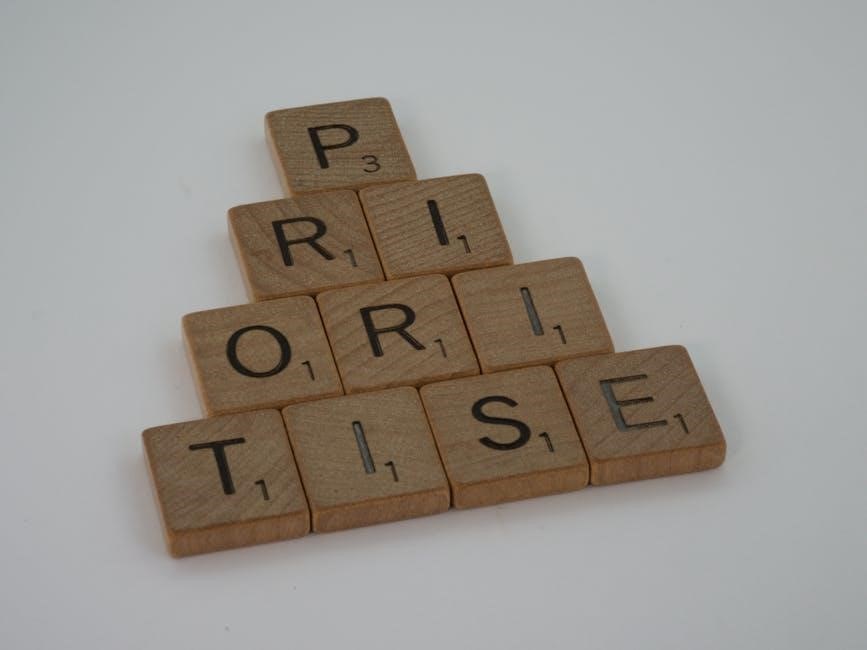
ELL lesson plans are tailored to meet the needs of non-native English speakers, focusing on language development through interactive activities, cultural sensitivity, and structured learning objectives.
1.1 Definition and Importance of ELL Lesson Plans
ELL lesson plans are structured frameworks designed to help non-native English speakers develop language proficiency. They are essential for providing clear learning objectives, cultural sensitivity, and tailored activities to meet diverse student needs. While pre-made plans often require adjustments, they offer a starting point for teachers to ensure comprehensive skill development, including pronunciation, listening, and reading/writing. Professional materials and textbooks are highly recommended for their adaptability and professional design, enabling educators to create effective curricula that cater to various learning styles and environments. These plans are crucial for fostering student progress and teacher confidence in ELL instruction.
1.2 Overview of Lesson Plan Structure
A well-structured ELL lesson plan typically includes clear learning objectives, a warm-up activity, grammar or vocabulary focus, reading/writing exercises, speaking/listening practice, and cultural integration. It also incorporates assessments and reflection. Many pre-made plans, while often rigid, provide a foundation that can be adapted to specific classroom needs. Professional materials, such as textbooks, offer more flexibility and comprehensive coverage of essential skills. Additionally, tools like Microsoft Word and OneDrive enable easy sharing and collaboration on lesson plan designs. A structured approach ensures balanced skill development and alignment with student proficiency levels, making lessons effective and engaging for ELLs.
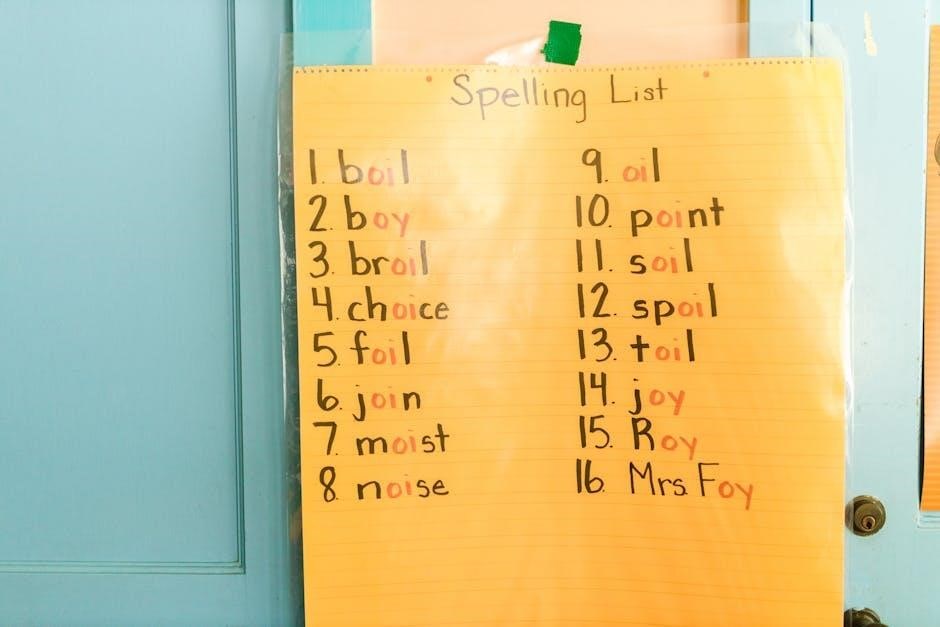
Understanding the Target Audience
ELL students have diverse proficiency levels, cultural backgrounds, and learning needs, requiring tailored lesson plans that address individual differences and promote inclusive language acquisition.
2.1 Identifying ELL Student Needs and Proficiency Levels
Identifying ELL student needs involves assessing their English proficiency levels, cultural backgrounds, and individual learning goals. Teachers must evaluate students’ strengths and challenges to create personalized lesson plans. Proficiency levels range from beginner to advanced, with each requiring tailored strategies. Beginner students may focus on basic vocabulary and grammar, while advanced students refine reading and writing skills. Understanding these needs ensures that instruction is relevant and effective, fostering a supportive learning environment that caters to diversity and promotes language acquisition.
2.2 Cultural Considerations in Lesson Planning
Cultural considerations are crucial when designing ELL lesson plans. Teachers must acknowledge students’ diverse backgrounds, traditions, and experiences to create an inclusive environment. Incorporating multicultural materials ensures relevance and engagement. Being sensitive to cultural differences in communication styles, values, and beliefs helps build trust. Additionally, recognizing the role of students’ first languages can enhance learning. Cultural responsiveness fosters a positive classroom atmosphere, promoting academic success and social integration. By addressing these factors, educators ensure that all students feel valued and supported in their language acquisition journey.
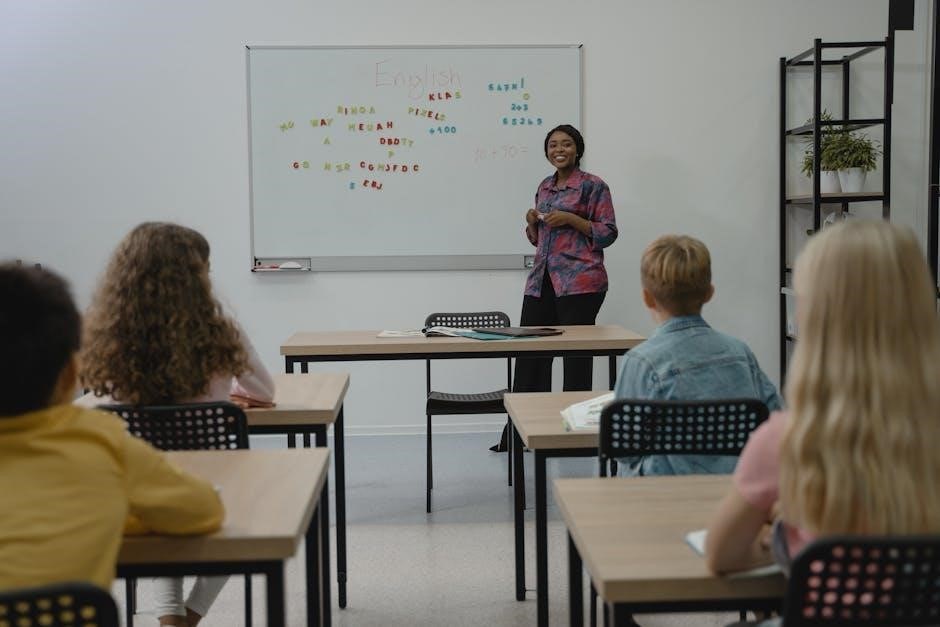
Key Components of Effective ELL Lesson Plans
Effective ELL lesson plans require clear objectives, engaging activities, formative assessments, cultural considerations, and technology integration to meet diverse student needs and promote language development.
3.1 Clear Learning Objectives
Clear learning objectives are essential in ELL lesson plans as they provide direction and focus for both teachers and students. Objectives should be specific, measurable, and aligned with language proficiency standards. For example, they might target vocabulary acquisition, grammar understanding, or communication skills. Well-defined objectives ensure that instruction is purposeful and helps students progress toward language mastery. Additionally, they enable teachers to assess student performance effectively and make data-driven decisions. Clear objectives also foster accountability and ensure that lessons are tailored to meet the unique needs of English language learners. They are the foundation of an effective and structured ELL lesson plan.
3.2 Interactive and Engaging Activities
Interactive and engaging activities are crucial for ELL students to practice and reinforce language skills in a dynamic environment. These activities, such as role-playing, group discussions, and hands-on tasks, encourage active participation and collaboration. Incorporating technology, like educational apps or multimedia resources, can further enhance engagement. Pairing students for peer work or incorporating real-life scenarios helps build confidence and fluency. Such activities not only make learning enjoyable but also provide opportunities for immediate feedback and correction. By integrating diverse and meaningful interactions, teachers can cater to varied learning styles and promote language development effectively.
3.3 Assessment and Feedback Mechanisms
Effective assessment and feedback mechanisms are vital for monitoring ELL students’ progress and guiding their improvement. Formative assessments, such as quizzes and oral presentations, help identify strengths and areas needing attention. Summative assessments, like written assignments, evaluate overall proficiency. Providing clear, constructive feedback is essential, using visual aids and simplified language to ensure understanding. Incorporating self-assessment and peer review fosters independence and collaboration. Technology can enhance feedback delivery through platforms offering instant responses and progress tracking. These strategies ensure comprehensive evaluation and support tailored to ELLs’ unique needs, promoting continuous language development and academic success.

Available Resources for ELL Lesson Plans
Discover a variety of resources, including downloadable PDFs, educational websites, and professional textbooks, designed to support ELL instruction with engaging and structured lesson plans.
4.1 Popular Websites and PDF Repositories
Teachers can access numerous websites offering free and paid ELL lesson plans in PDF format. Platforms like Teachers Pay Teachers and Education.com provide a wide range of downloadable resources tailored for ELLs. Google for Education also hosts a variety of materials, including printable worksheets and interactive activities. Additionally, repositories like TES Resources and BusyTeacher offer extensive libraries of ELL-specific lesson plans and activities. These websites cater to diverse proficiency levels, ensuring teachers can find materials that align with their students’ needs, from basic vocabulary exercises to advanced writing prompts.
4.2 Textbooks and Professional Materials
Textbooks and professional materials are essential resources for ELL lesson planning. Popular textbooks like Oxford Discover and New Pathways provide structured lesson plans, activity sheets, and teacher guides tailored for ELLs. Professional materials, such as The ELL Teacher’s Toolbox, offer practical strategies and downloadable templates. These resources cater to diverse proficiency levels, ensuring comprehensive coverage of language skills. Many textbooks include accompanying CDs or online supplements with audio and multimedia tools. Educators can also find textbooks aligned with educational standards, making them reliable for curriculum design and implementation in ELL classrooms.
4.3 Microsoft and OneDrive Resources
Microsoft and OneDrive offer a wealth of resources for ELL lesson planning. Educators can access customizable templates and lesson plan examples through Microsoft Word and PowerPoint; OneDrive provides cloud storage for easy sharing and collaboration. Microsoft Teams integrates with these tools, enabling educators to co-author lesson plans and share materials seamlessly. Additionally, Microsoft offers interactive tools like quizzes and flashcards that can be embedded into lessons. These resources support differentiated instruction and foster engagement among ELL students. By leveraging Microsoft tools, teachers can create dynamic, adaptable lesson plans tailored to their students’ needs.

Best Practices for Creating ELL Lesson Plans
Effective ELL lesson plans incorporate clear objectives, scaffolded instruction, and opportunities for interaction. They integrate language and content learning, use visual aids, and provide constructive feedback to enhance comprehension and engagement.
5.1 Incorporating Pronunciation Practice
Incorporating pronunciation practice into ELL lesson plans is essential for improving fluency and comprehension. Activities like minimal pair drills, repetition exercises, and audio modeling help students differentiate sounds. Using audio resources, such as podcasts or pronunciation apps, allows learners to hear and mimic native speaker intonation and stress. Interactive tools like Forvo or YouGlish can also enhance practice. Incorporating role-plays or chants in class encourages authentic use of language. Pronunciation practice should be integrated regularly, with opportunities for feedback to address common errors and build confidence in speaking. Consistent practice helps students develop clearer, more accurate speech patterns over time.
5;2 Developing Listening and Speaking Skills
Developing listening and speaking skills is crucial for ELLs to communicate effectively. Lesson plans should incorporate scaffolded activities, such as listening comprehension exercises, group discussions, and role-plays. Authentic materials like podcasts, videos, and news clips expose learners to real-life language use. Interactive tasks, such as think-pair-share and presentations, encourage active participation. Technology tools like speech-to-text apps and audio recorders provide opportunities for self-assessment and feedback. Teachers should model clear speech, adjust speaking rates, and provide visual aids to support comprehension. Balanced practice in both skills fosters confidence and fluency, preparing students for real-world interactions.
5.3 Enhancing Reading and Writing Abilities
Enhancing reading and writing abilities in ELLs involves scaffolded instruction and authentic materials. Lesson plans should include guided reading sessions, vocabulary building, and comprehension strategies. Writing workshops can focus on sentence structure, grammar, and creative expression. Incorporating visual aids and graphic organizers helps learners organize ideas. Differentiated instruction ensures tasks align with proficiency levels. Technology tools, such as text-to-speech software, support writing development. Peer reviews and self-assessment foster improvement. Integrating reading and writing with other skills promotes holistic language development, preparing ELLs for academic success and lifelong communication.
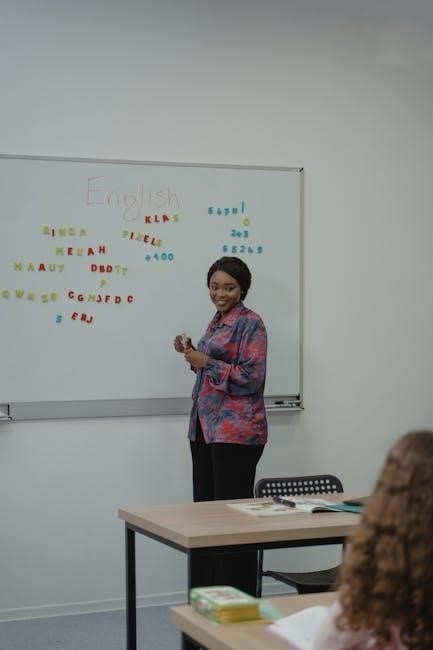
Differentiated Instruction for Diverse Learners
Differentiated instruction tailors lessons to meet varied ELL needs, ensuring equitable access to content. Strategies include tiered assignments, learning centers, and technology integration to support diverse learners effectively.
6.1 Tiered Assignments
Tiered assignments cater to diverse ELL proficiency levels by providing varying complexity and scaffolding. Teachers design tasks that align with learners’ language skills, ensuring accessibility and challenge. Lower-tier activities focus on basic comprehension, while higher tiers emphasize critical thinking and complex language use. This approach fosters inclusivity, allowing students to progress at their own pace. Incorporating visual aids, group work, and technology-enhanced tasks further supports differentiation. Regular formative assessments help educators adjust tier levels, ensuring each student’s needs are met effectively. This strategy promotes equity and engagement in ELL classrooms.
6.2 Learning Centers and Group Work
Learning centers and group work are dynamic strategies that promote active participation and collaboration among ELLs. These structured activities allow students to engage in hands-on tasks, fostering language development through interaction. Group work encourages peer support, cultural exchange, and teamwork, while learning centers provide focused practice on specific skills like listening, speaking, or vocabulary. Teachers can design themed stations or collaborative projects tailored to students’ interests and proficiency levels. This approach not only enhances language acquisition but also builds confidence and social skills. It ensures ELLs receive personalized attention while working collectively toward shared goals.
6.3 Technology Integration
Technology integration is a powerful tool for enhancing ELL lesson plans, offering interactive and personalized learning experiences. Digital resources like language learning apps, educational software, and online platforms provide engaging ways to practice vocabulary, grammar, and pronunciation. Tools such as digital flashcards, interactive whiteboards, and multimedia presentations can cater to diverse learning styles. Additionally, technology facilitates collaboration through online group work and real-time feedback mechanisms. By incorporating technology, teachers can differentiate instruction, increase student engagement, and provide accessible learning opportunities. This approach ensures ELLs develop both language skills and digital literacy, preparing them for modern educational and professional environments.

The Role of Technology in ELL Instruction
Technology enhances ELL instruction by providing interactive tools, personalized learning, and access to diverse resources, fostering engagement and language development while preparing students for future challenges.
7.1 Educational Software and Apps
Educational software and apps play a vital role in ELL instruction by offering interactive, personalized learning experiences. Popular tools like Duolingo, Babbel, and Rosetta Stone provide engaging activities tailored to diverse proficiency levels. These platforms often include pronunciation drills, vocabulary exercises, and cultural insights, making language acquisition immersive and effective. Many apps also offer progress tracking, allowing teachers to monitor student development and adjust lesson plans accordingly. Additionally, these tools support differentiated instruction by catering to individual learning styles and pacing, ensuring that all ELLs can access content that meets their unique needs and fosters meaningful language growth.
7.2 Online Collaboration Tools
Online collaboration tools enhance ELL instruction by fostering communication and teamwork among students. Platforms like Google Workspace, Microsoft Teams, and Zoom enable real-time interaction, allowing ELLs to practice language skills in group settings. Tools such as Breakout Rooms in Zoom facilitate smaller discussions, promoting active participation and pronunciation practice. Additionally, collaborative platforms like Trello and Padlet support task-based learning, where students can contribute to shared projects and engage in peer feedback. These tools not only enhance engagement but also bridge cultural gaps, creating an inclusive environment for language development and cross-cultural exchange.
7.4 Microsoft Tools for ELLs
Microsoft offers a range of tools to support ELLs, enhancing their language learning experience. Microsoft Translator provides real-time translation, aiding comprehension and communication. Immersive Reader, available in OneNote and Teams, supports reading skills with features like text-to-speech and visual aids. Microsoft Teams enables interactive lessons and group work, fostering collaboration. These tools cater to diverse needs, making learning accessible and inclusive. By integrating these technologies, educators create engaging and effective language instruction tailored to ELLs.
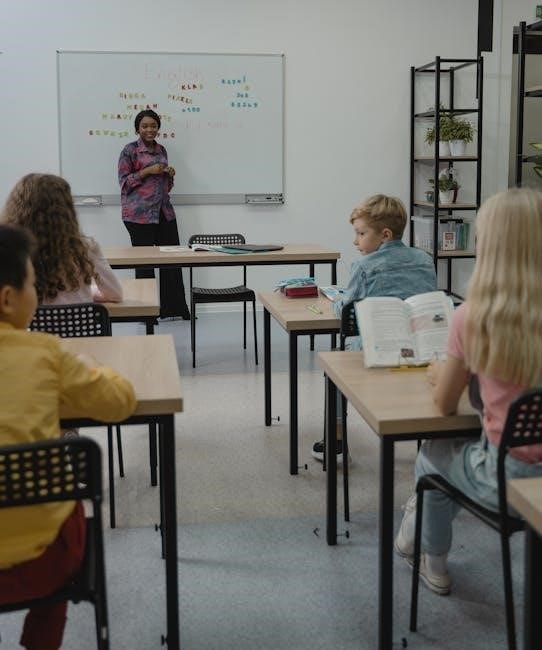
Cultural Sensitivity in Lesson Planning
Cultural sensitivity in lesson planning involves incorporating diverse materials and being aware of cultural differences to create an inclusive learning environment that respects all students’ backgrounds.
8.1 Incorporating Multicultural Materials
Incorporating multicultural materials into ELL lesson plans ensures diverse perspectives are represented, fostering inclusivity. Use textbooks, online resources, and multimedia that reflect students’ cultural backgrounds. This validates their experiences and helps bridge cultural gaps. Multicultural materials also expose students to global traditions, enhancing cross-cultural understanding. Teachers can integrate literature, music, and art from various cultures to enrich lessons. Additionally, incorporating students’ native languages and cultural references makes learning more relatable. This approach promotes engagement and creates a welcoming classroom environment where all learners feel valued and connected to the curriculum. Multicultural materials are essential for culturally responsive teaching and meaningful language acquisition.
8.2 Addressing Cultural Differences
Addressing cultural differences in ELL lesson plans involves understanding and respecting students’ diverse backgrounds. Teachers should recognize potential cultural nuances that may impact learning, such as communication styles or societal norms. Incorporating culturally responsive practices, like acknowledging holidays or traditions from students’ cultures, fosters inclusivity. Additionally, teachers should be sensitive to language barriers and adapt materials to meet cultural needs. By creating a safe and respectful environment, educators can bridge cultural gaps and promote mutual understanding. This approach not only enhances language acquisition but also builds students’ confidence and sense of belonging in the classroom.

Assessment Strategies for ELLs
Effective assessment strategies for ELLs involve formative and summative evaluations, ensuring alignment with language proficiency levels and learning goals. Adaptations are crucial to accurately measure progress and understanding.
9.1 Formative and Summative Assessments
Formative assessments monitor ELL progress during lessons, providing immediate feedback through quizzes, exit tickets, and oral responses. Summative assessments evaluate mastery at the end of units or terms, using tests, projects, or presentations. Both types are adapted to ELLs’ language levels, ensuring fair measurement of comprehension and skills. These assessments guide instructional planning and help identify areas needing additional support, fostering a balanced approach to evaluating language development and academic achievement; Regular use of these strategies ensures ELLs receive targeted feedback, promoting continuous improvement in their English proficiency and subject knowledge.
9.2 Non-Traditional Assessment Methods
Non-traditional assessments for ELLs include portfolios, projects, and presentations, allowing students to demonstrate language skills creatively. These methods accommodate diverse learning styles and proficiency levels, reducing test anxiety. Interactive activities like role-playing, discussions, and reflective journals also serve as assessments. Technology tools, such as voice recordings and digital presentations, provide alternative ways for ELLs to showcase their progress. These approaches help teachers track development and identify strengths and areas for improvement, fostering a more comprehensive understanding of each student’s abilities and needs in a supportive and engaging manner.
Professional Development for ELL Teachers
Professional development for ELL teachers includes workshops, webinars, and mentorship programs to enhance instructional strategies and cultural awareness, ensuring effective teaching for diverse learners.
10.1 Workshops and Webinars
Workshops and webinars are essential for ELL teachers to gain practical insights and strategies. These sessions often focus on best practices, such as differentiated instruction, language acquisition theories, and integrating technology. Webinars offer flexibility, allowing teachers to participate remotely and access resources like PDF guides. Workshops provide hands-on training, enabling educators to practice new methods and share experiences; Both formats help teachers understand ELL student needs, cultural considerations, and effective lesson planning. They also cover assessment techniques and tools to monitor student progress. Regular participation in these professional development opportunities ensures teachers stay updated on evidence-based practices and innovative teaching methods.
10.2 Peer Collaboration and Mentorship
Peer collaboration and mentorship are vital for ELL teachers to share resources and strategies. Teachers can exchange lesson plan PDFs, discuss challenges, and refine teaching methods. Mentorship programs pair experienced educators with newcomers, offering guidance on classroom management and differentiated instruction. Collaborative planning sessions foster creativity and ensure alignment with ELL student needs. Peer feedback and support networks help teachers adapt to diverse learner profiles and integrate cultural considerations effectively. These collaborative efforts enhance professional growth, improve lesson design, and ultimately benefit ELL students by providing tailored and impactful instruction grounded in shared expertise and resources.

Overcoming Common Challenges
ELL instruction often faces challenges like language barriers and cultural differences. Teachers can overcome these by leveraging PDF lesson plans, differentiated strategies, and professional development.
11.1 Managing Class Diversity
Managing a diverse ELL classroom requires tailored strategies to address varying proficiency levels and cultural backgrounds. Teachers can use PDF lesson plans to design tiered assignments, ensuring each student receives appropriate challenges. Incorporating multicultural materials fosters inclusivity and engagement. Technology tools, such as interactive apps, can cater to different learning styles. Encouraging peer collaboration helps bridge language gaps and builds mutual respect. By leveraging these strategies, educators create an inclusive environment that supports all learners, regardless of their background or language proficiency.
11.2 Motivating Reluctant Learners
Motivating reluctant ELL learners requires a supportive and inclusive approach. Teachers can use PDF lesson plans to incorporate engaging activities and real-life contexts, making learning relevant. Building rapport and fostering a positive classroom environment helps students feel comfortable. Providing positive reinforcement and celebrating small achievements boosts confidence. Interactive games, multimedia resources, and peer discussions can also spark interest. Understanding the learners’ backgrounds and addressing any cultural or personal barriers is key. By tailoring instruction to meet individual needs, educators can re-engage hesitant students and promote a love for learning.
Effective ELL lesson plans are crucial for language development. Future advancements in PDF resources and technology will enhance accessibility and engagement, fostering better learning outcomes for all students.
12.1 Summary of Key Points
Effective ELL lesson plans prioritize student needs, cultural sensitivity, and interactive activities. They incorporate clear objectives, assessments, and technology to enhance learning. Differentiated instruction and collaboration tools cater to diverse learners, while professional development supports teachers. PDF resources and digital platforms offer accessible materials, ensuring engaging and tailored instruction. Continuous improvement through feedback and innovation is essential for fostering language proficiency and academic success among ELLs, preparing them for future challenges and opportunities in an ever-evolving educational landscape.
12.2 Continuous Improvement in ELL Education
Continuous improvement in ELL education requires ongoing refinement of lesson plans, informed by teacher feedback and comprehensive analysis of student performance data. Integrating innovative technologies, such as interactive language learning apps and multimedia resources, alongside evidence-based methodologies, ensures the relevance and effectiveness of instructional practices. Professional development opportunities for educators are crucial, enabling them to adopt new strategies and adapt to the diverse and evolving needs of ELLs. By regularly updating resources and staying attuned to best practices, ELL education can evolve to better support student success and foster a more engaging and inclusive learning environment effectively.
Additional Resources
Explore ESL Library and Teachers Pay Teachers for diverse ELL lesson plan PDFs, offering customizable materials to cater to various proficiency levels and learning needs effectively.
13.1 Recommended Websites
For high-quality ELL lesson plans in PDF format, visit ESL Library, offering a wide range of interactive and leveled materials. Teachers Pay Teachers provides customizable lesson plans tailored to diverse learner needs. Additionally, BusyTeacher features free, downloadable PDFs covering grammar, vocabulary, and speaking activities. These platforms cater to various proficiency levels and are regularly updated with new resources. They are ideal for educators seeking structured and adaptable ELL materials to enhance classroom instruction and meet student needs effectively.
13.2 Suggested Textbooks
For comprehensive resources on ELL lesson planning, consider textbooks like The ESL/ELL Teacher’s Survival Guide by Larry Ferlazzo and Katie Sypnieski, which offers practical strategies for classroom instruction. Another excellent option is English Language Learners: The Essential Guide by Keith Folse, providing detailed lesson ideas and activities. Additionally, Making Content Comprehensible for English Learners by Jana Echevarría focuses on integrating language and content instruction. These textbooks are invaluable for educators seeking structured, research-based approaches to teaching ELLs and align well with PDF lesson plan formats for easy implementation.